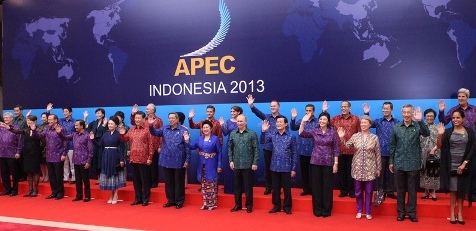Parties to the negotiations on the TPP should not ignore China’s concerns that the TPP and other major international trade agreement s represent attempts to economically “contain” China’s rise. Aiming for inclusive, rather than exclusive trade pacts, argues Paul Saunders, would make not only economic sense but political and strategic sense , too .
* * *
Notwithstanding President Barack Obama’s decision to remain in Washington to manage ongoing budget and debt talks with Congress, the Asia-Pacific Economic Cooperation summit in Bali appears to have produced modest progress toward the Trans-Pacific Partnership trade agreement. Success with TPP would be a major accomplishment for the United States, Japan, and other participating countries and could produce substantial economic and strategic benefits.

Nevertheless, its participants should also take care to avoid potentially counterproductive unintended consequences, particularly in their relations with China.
China’s new President Xi Jinping had an opportunity to shine in Mr. Obama’s absence and by all accounts he did. Press reports from the summit describe other APEC leaders jockeying for opportunities to interact with Xi—as well as a unique and massive media center to promote Beijing’s role and perspectives. As a result, many described the event as a diplomatic victory for China’s leaders, and perhaps it was.
But whatever warm glow Mr. Xi may have felt in his hotel suite following the final day’s events is likely tempered by growing anxiety about the TPP’s progress. Although it is the world’s second largest economy and recently became the number one trading nation, China could face significantly greater competition from TPP members if the agreement is realized. TPP participants make up over 40% of world trade, while China is responsible for about 10% of global merchandise trade and around 5% of the international market in services.
Worse from China’s perspective, TPP is not the only major international trade agreement currently under negotiation. The United States is simultaneously pursuing the Transatlantic Trade and Investment Partnership with the European Union—and the EU represents approximately 19% of world trade. If both TPP and TTIP are successful, America would be at the center of a global free trade system accounting for 60% of international trade, without even considering Washington’s other existing trade pacts, most notably with South Korea and Mexico.
Setting aside America’s current political dysfunction, the success of these two agreements could reinvigorate both the US economy (and, of course, those of the others involved) and Washington’s international leadership. It would also demonstrate compellingly Washington’s power to attract partners, despite its occasional mistakes—a power that China still lacks.
Maintaining Openness
Creating TPP and TTIP at the same time could well look like—from China’s perspective—a form of economic containment, particularly because commentators in Asia, Europe, and the United States are all describing the agreements as not only economically important but strategically necessary in managing China’s rise. As a result, if the two trade agreements are not handled carefully, they could contribute to a dangerous backlash in China that might undermine their strategic benefits.
From a historical perspective, major powers that feel increasingly isolated have generally looked for new allies and partners to strengthen their political, economic, or military position. With this in mind, China is likely to seek partners outside TPP and TTIP—and looks like it is already doing so. This is most evident in Beijing’s increasingly active efforts to cultivate Moscow and its expanding engagement in Central Asia and the Middle East.
At the same time, the United States is disengaging in Central Asia—as the war in Afghanistan winds down—and appears likely to reduce its energy imports from the Middle East, a key component of the US role there. A new Silk Road linking the Middle East, Central Asia, and China—an idea that currently seems to have wide support from not only these nations but also the United States and Europe—could promote this kind of integration, especially if Moscow and others successfully develop the Eurasian Economic Community.
The critical question for the major economies participating in all of these ventures is whether they will be inclusive or exclusive. Inclusive new groups that lower barriers and expand trade could energize the global economy, forming large and important building blocks for worldwide trade liberalization. Conversely, however, exclusive and competitive groups could lead to growing trade tensions while giving away the potential benefits of wider and deeper economic integration. That path would likely heighten political tensions as well—and the consequences could be costly for all.
With all of this in mind, it is quite important for the United States, Japan, and others discussing the TPP to ensure that any eventual agreement is clearly open to new members, including China. This not only makes economic sense—by expanding the boundaries of freer trade and prosperity—but political and strategic sense too.
Eventually bringing China into the TPP could require one of the most complex and difficult trade negotiations in history—not to mention challenging work in Beijing to meet the agreement’s appropriately high standards—but would be well worth it. Until then, leaders in the United States and other parties to the talks should more clearly state this goal and look for ways to take small steps toward it.
